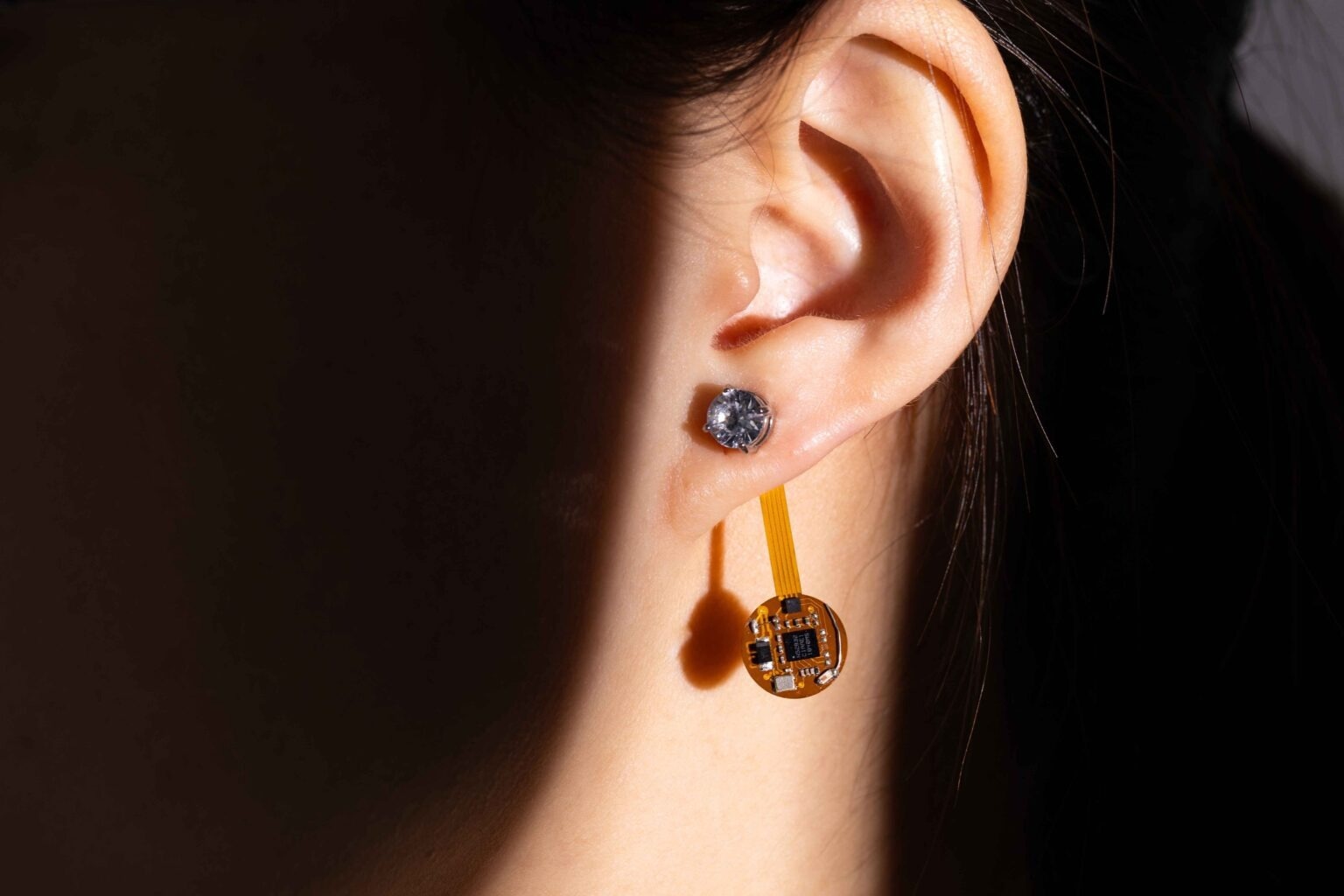There is a growing trend for smart accessories. Vital signs are tracked by watches and rings, and modern Ray-Bans have microphones and cameras built in. Even brooches have become fashionable thanks to wearable technology. But some accessories still lack the sophisticated touch.

University of Washington researchers introduced the Thermal Earring, a wireless wearable that continuously monitors a user’s earlobe temperature. Image Credit: Raymond Smith/University of Washington
Researchers at the University of Washington unveiled the Thermal Earring, a wearable that is wireless and tracks the temperature of the user's earlobes continuously. The earring performed better at measuring skin temperature during rest periods than a smartwatch did in a study involving six users. Additionally, it demonstrated promise in tracking ovulation, eating, exercise, and stress indicators.
With a 28-day battery life, the smart earring prototype weighs and measures about the same as a tiny paperclip. One temperature sensor is fastened to the wearer's ear using a magnetic clip, and a second sensor, which measures the room temperature, hangs slightly below it. Without compromising its accuracy, the earring can be customized with fashion designs crafted from resin, such as flowers, or with gemstones.
The Proceedings of the ACM on Interactive, Mobile, Wearable, and Ubiquitous Technologies published the researchers’ findings. The gadget is not offered for sale just yet.
I wear a smartwatch to track my personal health, but I’ve found that a lot of people think smartwatches are unfashionable or bulky and uncomfortable. I also like to wear earrings, so we started thinking about what unique things we can get from the earlobe. We found that sensing the skin temperature on the lobe, instead of a hand or wrist, was much more accurate. It also gave us the option to have part of the sensor dangle to separate ambient room temperature from skin temperature.
Qiuyue (Shirley) Xue, Study Co-Lead Author and Doctoral Student, Computer Science and Engineering, Paul G. Allen School, University of Washington
It was an engineering challenge to make a wearable small enough to be mistaken for an earring and durable enough so that users would only need to charge it occasionally.
It’s a tricky balance. Typically, if you want power to last longer, you should have a bigger battery. But then you sacrifice size. Making it wireless also demands more energy.
Yujia (Nancy) Liu, Study Co-Lead Author and Master Student, Electrical and Computer Engineering Department, University of Washington
Now Yujia (Nancy) Liu is at the University of California, San Diego.
In addition to designing the earring with as little power consumption as possible, the team had to accommodate a Bluetooth chip, a battery, two temperature sensors, and an antenna. The earring uses Bluetooth advertising mode, which is the transmission a device broadcasts to indicate it can be paired, as opposed to pairing it with a device, which consumes more power. It sends and reads the temperature before entering a deep sleep to conserve energy.
The team also looked into possible applications because there has not been much research done on continuous earlobe temperature. This will help direct future studies. The average earlobe temperature increased by 10.62 ºF (5.92 ºC) in five feverish patients when compared to the temperatures of 20 healthy patients, indicating the potential for continuous fever monitoring with the earring.
In medicine we often monitor fevers to assess response to therapy - to see, for instance, if an antibiotic is working on an infection. Longer term monitoring is a way to increase sensitivity of capturing fevers, since they can rise and fall throughout the day.
Dr. Mastafa Springston, Study Co-Author and Clinical Instructor, Department of Emergency Medicine, School of Medicine, University of Washington
There are several new applications for the Thermal Earring because, outside of fever, earlobe temperature varies more than core body temperature. The earring detected temperature variations in small proof-of-concept tests that correlated with eating, exercising, and feeling stressed. The earring's average reading varied by 0.58 ºF (0.32 ºC) when tested on six users at rest; this puts it within the 0.28 ºC to 0.56 ºC range required for tracking periods and ovulation; a smartwatch varied by 0.72 ºC.
Xue says, “Current wearables like Apple Watch and Fitbit have temperature sensors, but they provide only an average temperature for the day, and their temperature readings from wrists and hands are too noisy to track ovulation. So we wanted to explore unique applications for the earring, especially applications that might be attractive to women and anyone who cares about fashion.”
Although the focus of the research was on the variety of potential uses, the researchers discovered a number of interesting potential applications for the Thermal Earring; however, their findings were preliminary. Before the device is made available to the general public, more data is required to train their models for each use case, and more extensive testing is required.
Xue is working on integrating activity monitoring and heart rate monitoring into future iterations of the device. Xue also thinks about using solar energy or the kinetic energy from swaying earrings to power the device.
Xue says, “Eventually, I want to develop a jewelry set for health monitoring. The earrings would sense activity and health metrics such as temperature and heart rate, while a necklace might serve as an electrocardiogram monitor for more effective heart health data.”
Joseph Breda, a Doctoral Student at the Allen School, was a co-author of the paper. Vikram Iyer, a Professor at the Allen School, and Shwetak Patel, a Professor at the Allen School and the Electrical and Computer Engineering Department, were co-senior authors. This research was funded by the Washington Research Foundation.
Journal Reference
Xue, S. Q., et.al (2024) Thermal Earring: Low-power Wireless Earring for Longitudinal Earlobe Temperature Sensing. ACM Journals.doi.org/10.1145/3631440
Source: https://www.washington.edu/